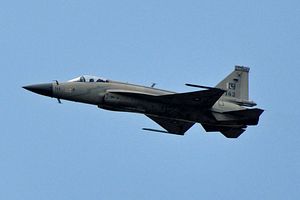The Pakistan Air Force (PAF) stood up a new fighter squadron composed of Aeronautical Complex/Chengdu Aerospace Corporation (PAC/CAC) JF-17 “Thunder” multirole fighter jets in Quetta, Balochistan last month, according to local media reports.
The new squadron, designated Number 28 “Phoenix,” is the sixth PAF unit to receive the JF-17 lightweight, single-engine, multirole combat aircraft to date. “From now on, No. 28 MR Squadron, equipped with Pakistan’s (…) JF-17, has the responsibility of providing day and night aerial defense of the country, especially along the western borders of Pakistan [shared with Iran and Afghanistan],” the PAF Chief of Air Staff Air Chief Marshal Sohail Aman was quoted as saying by the Associated Press of Pakistan (APP).
The PAF is expected to induct 150 JF-17 combat aircraft over the next years, split into three productions blocks: Block I, Block II, and Block-III. PAC has so far produced 50 Block I aircraft and 50 Block II JF-17s. Twelve more Block II JF-17 aircraft are expected to be rolled out in 2018. Pakistan is estimated to be capable of assembling up to 25 JF-17 aircraft per year without technical or logistical assistance from China. (PAC produces 58 percent of the airframe and CAC 42 percent.) Once the Block-II JF-17 order is complete this year, PAC will switch to producing the aircraft’s most advanced version.
Among other things, “the JF-17 Block III, the latest variant of the combat aircraft, will feature new avionics including Active Electronically Scanned Array (AESA) radar, which will replace the older Nanjing Research Institute of Electronic Technologies’ (NRIET) KLJ-7 X-band fire control radar, and a new electronic warfare system, among other things,” I summarized in 2017. A selected number of Block II and the future Block III variants also feature an in-flight refueling (IFR) probe, which suggests that the aircraft could be deployed for longer-range maritime strike missions. (The PAF and Navy have recently conducted a live-fire exercise, which included the launch of an anti-ship missile from a JF-17.)
Powered by a Russian designed but Chinese license-built Klimov RD-93 (a RD-33 derivative) turbofan engine, the aircraft can reportedly reach a top speed of up to Mach 1.6 and has an operational range of up to 1,200 kilometers without refueling. The fighter jet can be armed with a variety of weapons and features seven hardpoints. The JF-17 is reportedly capable of carrying a weapons payload of over 3.5 tons, including air-to-air, air-to-surface, and anti-ship missiles.
“The JF-17 was originally developed to replace the PAF’s aging fleet of Dassault Mirage III/5 fighter jets by 2o20,” I explained in 2016. “Pakistan is looking to replace 190 aircraft — primarily Chengdu F-7 and Dassault Mirage III/5 fighter jets — by 2020 presumably with a mixture of F-16 and JF-17 aircraft.”
Pakistan and China are also working on a two-seat trainer variant of the JF-17, dubbed JF-17B, which, according to some reports, could be the basis for the JF-17 Block III version of the aircraft.“In comparison to the single-seat JF-17, the JF-17B variant features a dorsal fin that contains an additional fuel tank,” I reported in May 2017. The aircraft prototype also has a slightly larger wingspan and a marginally modified nose section and features a larger swept-back vertical stabilizer housing a new three-axis fly-by-wire system.
Pakistan is looking to export the JF-17.































